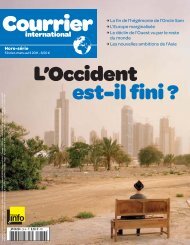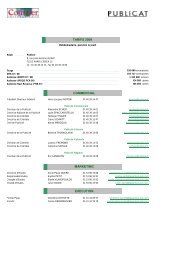2 ОРГАНИЗАЦИЯ И МЕТОДИКА РАБОТ - Courrier international
2 ОРГАНИЗАЦИЯ И МЕТОДИКА РАБОТ - Courrier international
2 ОРГАНИЗАЦИЯ И МЕТОДИКА РАБОТ - Courrier international
You also want an ePaper? Increase the reach of your titles
YUMPU automatically turns print PDFs into web optimized ePapers that Google loves.
introduction of a methyl substituent at position 5 and disappeared after the introduction of two<br />
methyl groups. While acene hydrocarbon (naphthalene, anthracene) and anthanthrene activity<br />
significantly increases after the introduction of two methyl substituents at position 2 and 6. It should<br />
be stressed that the products of PAH degradation in the environment can have even stronger<br />
oncogenic effect than initial substances under the influence of physico-chemical and<br />
microbiological factors, however, the monitoring of these PAH compounds and metabolites is a<br />
quite complex task is not practically carried out now.<br />
Organochlorine compounds<br />
Organochlorine compounds (OCC) are not typical for the nature; they are strictly of anthropogenic<br />
origin. OCC are the most hazardous group of persistent organic pollutants and are characterized by<br />
low water solubility (about 0.5 - 0.001 mg/l) and high lipid solubility and low solubility in organic<br />
solvents and lipids lipophilicity, low vapor pressure (10 -3 - 10 -5 at 20° C) and exceptional<br />
microbiological, chemical and thermal stability.<br />
The main persistent organochlorine compounds in the environment are organochlorine pesticides of<br />
various kinds (hexachlorocyclohexanes, DDT and its isomers, metabolites and by-products,<br />
polychlorocyclodienes, polychlorobenzenes, herbicides and defoliants based on 2,4-D acid and<br />
polychlorinated phenols) polychlorinated biphenyls (PCB) as well as polychlorodioxines and<br />
polychlorobenzofurans that have never been produced as chemical synthesis products, but have<br />
been introduced into the environment either as admixtures of other compounds or have been formed<br />
due to the burning of garbage, fires at plants producing chlorine-containing plastics, transformation<br />
of waste of paper and other material bleach.<br />
Polychlorinated biphenyls<br />
The group of polychlorinated biphenyls (PCB) includes 209 related compounds (known as<br />
congeners) which are the products of chlorination of diphenyl (biphenyl) and differ only in the level<br />
of substitution and mutual location of substituents.<br />
The characteristic feature of PCB production is that it is not oriented towards the production of<br />
separate compounds by means of direct chlorination of diphenyl but their mixtures of complex<br />
composition determined by the conditions and duration of the production process. Such mixtures<br />
could contain from 20 to 71 weight percent of chlorine, and its content was usually reflected in the<br />
trade name of the product by some means or other.<br />
Decachlorobiphenyl, a product of complete chlorination of diphenyl, was the only substance to be<br />
specially produced for the use as casting wax. Small quantities of PCB can be formed as by-<br />
products of some types of chemical synthesis during chlorination of water and thermal cracking of<br />
chlorine-containing organic substances.<br />
PCB mixtures have unique physical and chemical properties determining their wide use in the<br />
industry. They are as follows: nonflammability, resistance to acids and alkalis, oxidation and<br />
hydrolysis, low solubility in water, thermal resistance, wide range of dielectric characteristics and<br />
low vapor pressure at room temperature. The products synthesized and implemented as complex<br />
mixtures of polychlorinated biphenyls are liquids in a very wide range of temperatures (from 50°<br />
to 300° C).<br />
FINAL REPORT for Contract No. CS-NPA-Arctic-13/2009 of December 01, 2009 within the framework of pilot project Development of<br />
Technology of clean up of the area of Decommissioned Sites of The Russian Federation Ministry of Defense in the Arctic by the<br />
Example of Alexanra Island of Franz Josef Land Archipelago from Hazardous Waste<br />
73








